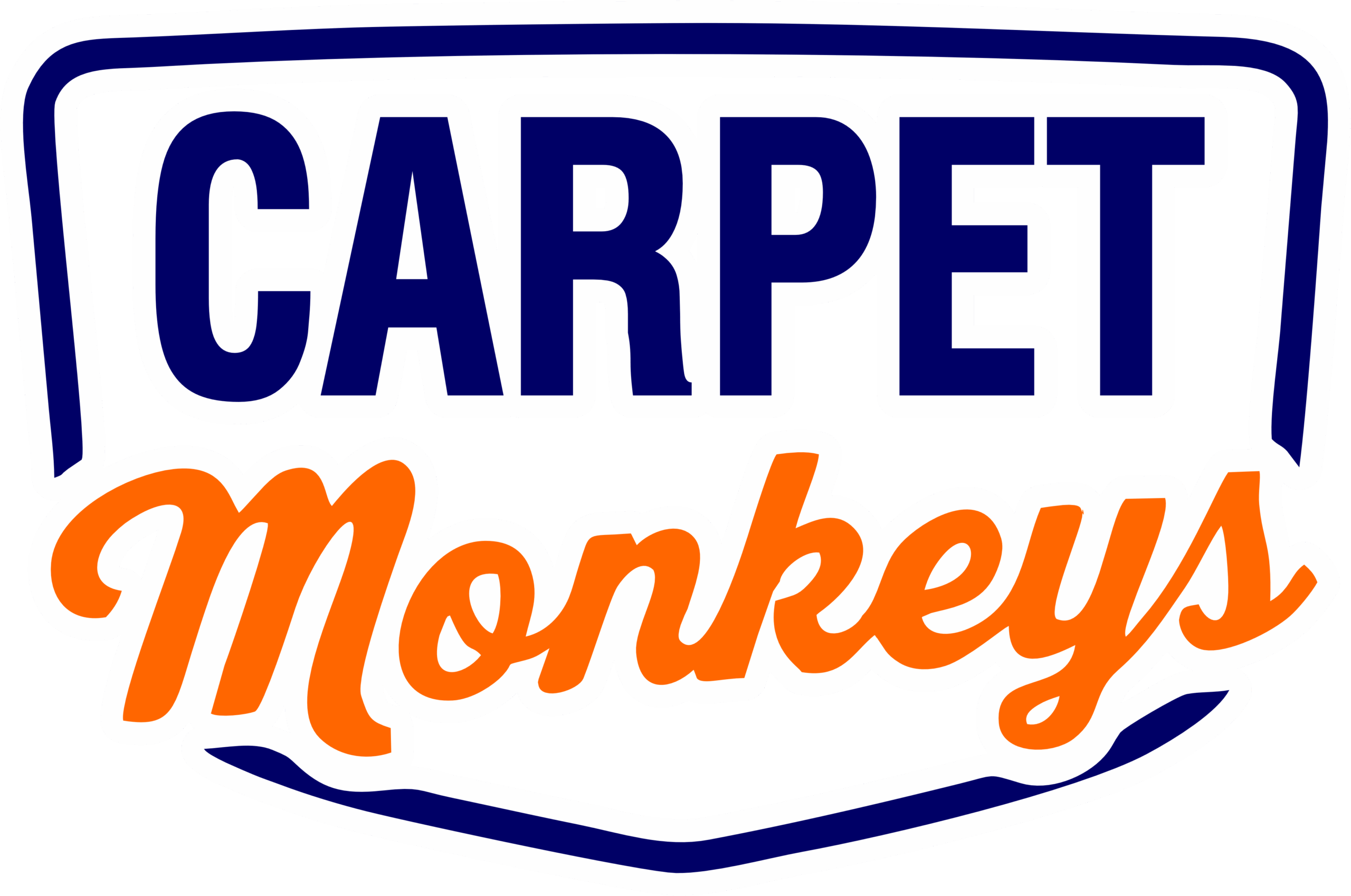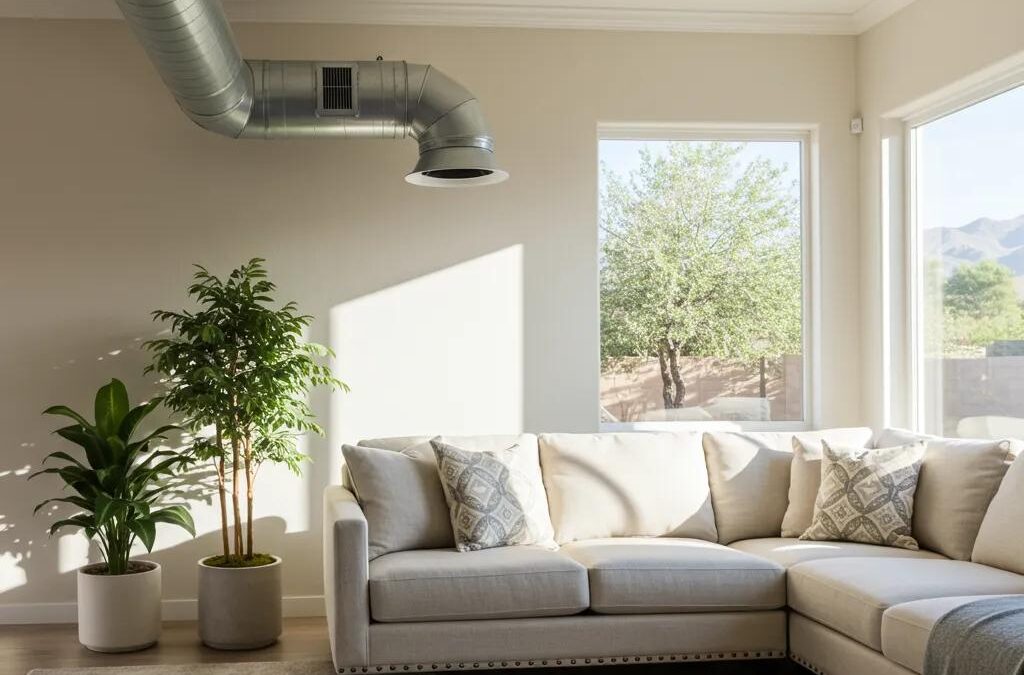Air duct cleaning is the targeted removal of dust, debris, and biological growth from the HVAC ductwork and vents that circulate air through a home. Regular cleaning improves indoor air quality and HVAC performance by removing pollutants that recirculate, reducing airborne particle load, and restoring designed airflow. Homeowners in the Las Vegas Valley face unique indoor air challenges—frequent dust, pollen influx, and episodic dust storms—that accelerate duct contamination and amplify allergy and respiratory triggers. This article explains how professional duct cleaning reduces pollutants, boosts HVAC efficiency, and lowers the risk of odor, mold, and equipment strain while offering practical guidance on cost, timing, and service components for residences across Las Vegas, Henderson, North Las Vegas, Spring Valley, Enterprise, Sunrise Manor, and Summerlin. You’ll find clear signs that indicate cleaning is needed, realistic energy and maintenance benefits, a breakdown of what professional services include, and straightforward pricing factors so you can decide when and how to schedule cleaning for healthier indoor air.
How Does Air Duct Cleaning Improve Indoor Air Quality in Las Vegas Valley?
Air duct cleaning improves indoor air quality by removing built-up particulates and biological contaminants from the HVAC air pathway, which reduces the quantity of irritants that are redistributed through supply vents and return vents. The mechanism involves mechanical agitation to dislodge debris, HEPA-grade vacuuming to capture particles, and optional sanitization to neutralize microbial growth; together these actions lower airborne particle counts and allergen reservoirs. In a desert climate where dust and pollen infiltration are common, cleaning reduces the frequency at which filters and coils load, helping the system deliver cleaner air more consistently. Below are the common pollutants removed and why removing each matters.
What Pollutants and Allergens Are Removed by Professional Air Duct Cleaning?
Professional duct cleaning targets a range of contaminants that accumulate in duct trunks, grilles, and vents. HEPA-filtered vacuums and agitation tools remove dust, pollen, pet dander, and settled particulate matter that act as allergy triggers for sensitive occupants. Technicians also remove mold spores and microbial residues where moisture or organic material allows growth, reducing a source of musty odors and respiratory irritation. Some services include sanitization steps to address bacteria and lingering odors, lowering overall VOC and odor loads and improving perceived air freshness. These removals directly reduce sources of indoor exposure for children, elderly residents, and asthma sufferers.
Research has explored various methods for cleaning HVAC ducts and their impact on airborne contaminants.
Effectiveness of HVAC Duct Cleaning on Airborne Particulates and Bioaerosols
Indoor air quality has emerged as a significant environmental concern, given that individuals spend approximately 22 hours indoors daily. The study reported herein investigated the efficacy of three commercial HVAC (Heating, Ventilation, and Air Conditioning) duct cleaning methodologies in reducing airborne particulate matter and viable bioaerosols. The three HVAC sanitation processes evaluated were: (1) Contact method, involving conventional vacuum cleaning of interior duct surfaces; (2) Air sweep method, utilizing compressed air to dislodge dirt and debris; and (3) Rotary brush method, employing a rotary brush inserted into the ductwork to agitate and dislodge debris. The effectiveness of these sanitation processes was assessed based on airborne particulate and viable bioaerosol concentrations within residential homes. Eight identical homes in the same neighborhood were selected. Two homes were subjected to each cleaning procedure, while two served as controls. It was observed that both particle count readings and bioaerosol concentrations increased during the cleaning process compared to pre- or post-cleaning levels, suggesting that dirt, debris, and other pollutants may become airborne due to disturbances caused by the cleaning procedures. Particle count readings for particles of 0.3-micron size increased, potentially due to cigarette smoking. However, particle counts at 1.0-micron size were reduced following HVAC duct cleaning. Post-cleaning bioaerosol concentrations, measured two days after cleaning, were found to be lower than pre-cleaning concentrations, indicating that the cleaning procedures were effective to some extent. Homes cleaned using the Air Sweep procedure exhibited the greatest reduction in bioaerosol concentration among the three investigated methods.
Effectiveness of HVAC duct cleaning procedures in improving indoor air quality, I Ahmad, 2001
How Does Cleaner Air Reduce Allergy and Respiratory Symptoms at Home?
Cleaner air reduces allergy and respiratory symptoms by lowering exposure to airborne triggers that cause immune and airway responses. When ducts are cleaned, fewer particulates circulate, which decreases irritation of nasal passages and bronchial pathways; this often translates to fewer sneezing episodes, less congestion, and improved sleep for allergic individuals. Reduced microbial and dust reservoirs also mean fewer chronic exposures that can exacerbate asthma or sinus conditions over time. For households with vulnerable occupants—children, seniors, or asthma sufferers—reducing indoor triggers through targeted cleaning is a practical step toward symptom reduction and better daily comfort.
Why Is Air Duct Cleaning Especially Important in the Desert Climate of Las Vegas?
Las Vegas’s desert climate accelerates duct contamination through frequent dust infiltration, seasonal pollen peaks, and occasional wind-driven sand events that introduce coarse particulates into homes. Low humidity can increase airborne dust suspension while higher indoor activities (pets, cooking) add organic matter that settles in ducts. Because of these factors, inspections and cleanings may be advisable more often than the typical baseline recommendation, particularly after major dust storms or renovations. Adjusted scheduling based on local events—dust storms, pollen season, or household changes—helps maintain IAQ and prevents accelerated HVAC wear.
Studies have investigated the nature of dust accumulation within ventilation systems.
Microbiological Contamination in Desert Environments and Indoor Air Quality
Microbiological air contamination in desert environments is an increasingly significant concern for the health of office building occupants and public health. This study assessed the concentrations and compositions of airborne microorganisms (bacteria and fungi) in indoor and outdoor environments, utilizing a multistory building complex in Kuwait as a case study. Airborne microorganism samples were collected from 12 sites within the nineteen-story building complex across four seasons. Culturable airborne bacteria and fungi were plated on selected media to determine their concentrations and compositions using a Biolog Omnilog GEN III system and Biolog MicroStation. Indoor mean airborne bacterial count concentrations ranged from 35 to 18,463 CFU/m³, with concentrations exceeding 2,000 CFU/m³ indicating high to very high contamination levels across all seasons. Fungal contamination was elevated in winter and summer, with detected concentrations greater than 2,000 CFU/m³. Indoor-to-outdoor (I/O) ratios indicated that airborne microbial contamination within the building floors originated from indoor air sources. All building floors exhibited bacterial and fungal concentrations ranging from less than 2,000 to over 2,000 CFU/m³, signifying high to very high air contamination levels. Statistical analysis revealed no correlation between bacterial and fungal concentrations, suggesting they originated from unrelated sources. Within the indoor building air, the most prevalent bacterial isolate was Bacillus pseudomycoides/cereus, while the most dominant fungal isolate was Aspergillus spp. The low count for indoor air bacterial species suggested no particular health risk for the occupants. Conversely, the high count of indoor air fungal species in winter samples and the presence of potentially allergenic genera detected may indicate possible health risks for the occupants. The results obtained form the basis for recommendations regarding maintenance activities.
Microbiological contamination of indoor and outdoor environments in a desert climate, MF Yassin, 2022
For homeowners seeking professional help, The Carpet Monkeys provides air duct cleaning services that target these exact pollutants and conditions. Their approach focuses on healthier homes and workplaces using safe, healthy cleaning solutions and experienced technicians who inspect, clean, and restore airflow. This practical option connects the IAQ benefits described here with a local service built to address Las Vegas Valley dust and allergen challenges.
What Are the Energy and HVAC Efficiency Benefits of Clean Air Ducts in Henderson and Surrounding Areas?
Clean ducts reduce airflow resistance in the HVAC system, restoring designed cubic feet per minute (CFM) and allowing the blower to deliver conditioned air more efficiently. Lower resistance reduces runtime and cycling frequency, which can translate into measurable energy and comfort improvements in hot climates where HVAC load dominates utility use. Removing particulates from ducts and grilles also reduces dust accumulation on coils and blower components, decreasing maintenance frequency and repair risk. The table below compares common HVAC components, the benefit of cleaning, and expected outcomes for homeowners.
Different HVAC components respond to cleaning with specific efficiency and lifespan outcomes.
| HVAC Component | Benefit of Cleaning | Expected Outcome |
|---|---|---|
| Ducts | Reduced airflow resistance | Improved CFM and fewer hot/cold spots |
| Blower motor | Less particulate buildup | Reduced strain and lower failure risk |
| Coils & filters | Cleaner surfaces | Better heat transfer and reduced energy use |
How Does Air Duct Cleaning Enhance HVAC Airflow and Reduce System Strain?
Removing accumulated debris lowers pressure drop across the duct network and improves overall system airflow, which increases delivered CFM to rooms and reduces the need for fans to work harder. Improved airflow helps eliminate hot or cold pockets and decreases the workload on compressors and blowers, leading to steadier operation. Homeowners often experience more even temperatures and quieter operation when resistance is reduced, and technicians can verify airflow improvements during inspection to quantify benefits.
What Energy Savings Can Homeowners Expect After Air Duct Cleaning?
Realistic energy savings depend on the degree of contamination, existing system efficiency, and local usage patterns; modest to moderate savings are common when ducts are heavily loaded. While estimates vary, improved airflow and reduced runtime can result in lower energy usage during peak cooling months in the Las Vegas Valley. Factors like duct leakage, insulation, and thermostat settings also affect savings, so cleaning should be considered part of a broader efficiency strategy rather than a standalone energy cure.
How Does Regular Cleaning Prolong the Lifespan of HVAC Systems?
Regular removal of particulates and biological material reduces abrasive wear on moving parts, prevents heat-exchange surface fouling, and lowers the incidence of clogs that can cause motor overwork. Cleaner components mean fewer emergency repairs and extended intervals between major servicing, which contributes to longer useful life for key parts such as blower motors and coils. Scheduling routine inspections and cleaning based on local dust exposure helps protect system investment and maintain reliability.
The scientific community has examined the effectiveness and mechanics of ventilation duct cleaning.
Dust Accumulation and Removal in Ventilation Ducts
This thesis investigates dust accumulation within and removal from newly installed supply air ducts, as well as the bristle behavior of rotating duct cleaning brushes. The findings regarding dust accumulation, measured via three distinct methods, were compared, and the quantity of dust in newly installed air ducts was assessed. The vacuum test proved to be an effective method for collecting dust samples from the duct surface. The vacuum test and the gravimetric tape method yielded comparable results when the measured dust accumulation on the duct surfaces ranged from 0.1 to 1.0 g/m². Both the gravimetric and optical tape methods are suitable for evaluating the cleanliness of new ducts within this dust accumulation range of 0.1 to 1.0 g/m².
Dust in ventilation ducts: accumulation, measurement and removal, 2004
What Is Included in Professional Air Duct Cleaning Services by The Carpet Monkeys?
Professional air duct cleaning typically includes a systematic inspection, mechanical agitation of ducts, HEPA vacuuming, optional sanitization, and a final inspection with report. The Carpet Monkeys’ service descriptions emphasize specific service attributes such as safe, healthy cleaning solutions, experienced technicians, and portable cleaning equipment for strong results, and they state a 100 percent satisfaction guarantee. Below is an entity-attribute-value table listing common service components and their contribution to IAQ and HVAC longevity.
This table maps core service components to their purpose and homeowner benefit.
| Service Component | Role in Cleaning | Homeowner Benefit |
|---|---|---|
| Inspection & assessment | Identify contamination & access points | Targeted, efficient cleaning |
| Mechanical agitation | Dislodge settled dust & debris | Improves debris removal effectiveness |
| HEPA vacuuming (portable equipment) | Capture particulates from ducts | Reduces airborne recirculation |
| Sanitization (optional) | Neutralize microbial growth | Lowers odor and microbial load |
What Advanced Equipment and Eco-Friendly Solutions Are Used?
Advanced duct cleaning uses inspection cameras, agitation tools (brushes and compressed air), and HEPA-filtered vacuum systems to remove particulates from duct trunks and vent openings. Portable cleaning equipment allows technicians to perform thorough work without large truck-mounted setups inside the home, improving access and reducing disruption. Eco-friendly solutions are formulated to be child- and pet-safe while providing targeted antimicrobial or odor-control action when sanitization is required. These tools and formulations together decrease airborne particles and minimize post-service chemical residue.
How Does The Carpet Monkeys Ensure 100% Satisfaction Guarantee?
A satisfaction guarantee typically means the provider commits to remediate any issues identified by the customer after service, using reinspection and rework if necessary. In practice this means technicians will return to address missed areas, clarify service scope, and ensure the customer is satisfied with results. The availability of this guarantee provides homeowners reassurance about service outcomes and aligns expectations around inspection reports and follow-up actions.
What Are the Steps in The Carpet Monkeys’ Air Duct Cleaning Process?
The standard homeowner-friendly process includes inspection, containment, agitation, vacuuming, optional sanitization, and final reporting. Each step verifies condition and documents results so homeowners see the before-and-after changes in particulate burdens and airflow. Clear stepwise procedures reduce surprises, improve transparency, and support the satisfaction guarantee and service quality claims.
- Inspection: Assess ducts and identify contamination level.
- Containment & agitation: Isolate areas and loosen debris.
- HEPA vacuuming with portable equipment: Remove dislodged particles.
- Sanitization (if requested) & final inspection: Address microbes and report findings.
This sequence is designed to restore airflow and reduce airborne contaminants while documenting the work for homeowner confidence.
Scientific reviews have synthesized findings on the effectiveness of various duct cleaning techniques.
Scientific Evidence on the Efficacy of Ventilation Duct Cleaning
Air velocities can influence microbial resuspension from duct surfaces, and the efficacy of cleaning methodologies may vary contingent upon the nature of contaminants and the duct material. Certain investigations suggest that mechanical cleaning techniques, such as brushing and vacuuming, are effective in removing particulate matter and debris from ducts. Conversely, other studies indicate that their effectiveness can be constrained, particularly for deeply embedded contaminants.
Is ventilation duct cleaning useful? A review of the scientific evidence, MS Zuraimi, 2010
How Much Does Air Duct Cleaning Cost in Las Vegas, North Las Vegas, and Nearby Areas?
Pricing depends on service scope, home size, duct complexity, and add-ons like sanitization or dryer vent cleaning. Typical local ranges vary, but homeowners should expect variability tied to square footage, number of supply and return vents, and the level of contamination found during inspection. The table below compares service types, factors that influence price, and typical variability notes for local markets.
Below is a concise pricing comparison to set expectations.
| Service Type | Pricing Factor | Typical Price Range / Note |
|---|---|---|
| Basic duct cleaning | Home size & vent count | Varies by inspection; get an estimate |
| Sanitization add-on | Microbial treatment needed | Additional cost depending on product & scope |
| Dryer vent cleaning | Accessibility & lint load | Priced separately or bundled with ducts |
What Factors Influence Air Duct Cleaning Prices Locally?
Local cost drivers include home square footage, number and complexity of duct runs, extent of contamination, and travel or accessibility constraints. Desert-specific factors—such as recent dust storms or frequent filter replacement history—can increase required work and therefore affect price. Service bundling (for example combining duct cleaning with dryer vent or carpet cleaning) can change per-service pricing and deliver greater overall value.
How Does Professional Cleaning Compare to DIY Methods?
- DIY risks: Incomplete removal of settled debris. Potential damage to ductwork or components. No warranty or satisfaction guarantee.
- Professional advantages: Specialized equipment and HEPA capture. Inspection, documentation, and follow-up. Service guarantees and trained technicians.
Are There Seasonal Discounts or Service Packages Available?
Many providers offer seasonal scheduling incentives around pre-summer or post-dust-storm periods and bundle discounts for multiple services like duct plus dryer vent or carpet cleaning. Homeowners should ask about package options that include filter changes, sanitization, or scheduled follow-up inspections to maximize both cost-effectiveness and IAQ benefits.
Which Signs Indicate You Need Air Duct Cleaning in Spring Valley, Enterprise, Sunrise Manor, and Summerlin?
- Visible dust or debris coming from vents.
- Persistent musty or chemical odors after airing out.
- Increased sneezing, coughing, or sinus issues among occupants.
- Rapid clogging of HVAC filters or inconsistent room temperatures.
How Can You Detect Poor Indoor Air Quality and Duct Contamination?
Detecting poor IAQ involves observing health patterns, smells, and visible dust movement. Track symptom timing (worse indoors vs. outdoors), inspect vents for dust lines, and note if certain rooms are consistently dustier. When multiple indicators align—health symptoms, visible debris, and fast filter clogging—calling a professional for inspection provides clarity and a remediation plan.
When Should You Schedule Air Duct Cleaning Based on Las Vegas Climate?
Schedule cleaning after major dust events, before peak cooling season, or following renovations that generate dust. A baseline inspection every 2–3 years is common, with more frequent checks in homes with pets, smokers, or occupants with allergies. Adjust timing upward after notable dust storms or when occupancy changes increase contamination risk.
How Does Regular Cleaning Prevent Mold, Odors, and Allergens?
Regular removal of organic deposits and settled dust reduces the substrate available for mold growth and eliminates many odor sources, lowering both microbial and allergen reservoirs. By decreasing moisture pockets and organic buildup in duct trunks and grilles, cleaning reduces conditions that lead to persistent odors and allergen accumulation. Consistent maintenance thus delivers fresher indoor air, fewer triggers for sensitive occupants, and improved HVAC hygiene.
For homeowners ready to act, The Carpet Monkeys serves the Las Vegas Valley neighborhoods mentioned and encourages scheduling a free estimate or inspection to assess contamination and recommend targeted services. Their local focus and service components help translate IAQ improvements into practical, measurable home benefits.
Frequently Asked Questions
What are the long-term benefits of regular air duct cleaning?
Regular air duct cleaning offers several long-term benefits, including improved indoor air quality, enhanced HVAC efficiency, and reduced energy costs. By consistently removing dust, allergens, and microbial growth, homeowners can experience fewer respiratory issues and allergies. Additionally, clean ducts help maintain the HVAC system’s performance, leading to a longer lifespan for equipment and fewer repairs. This proactive maintenance approach not only ensures a healthier living environment but also contributes to significant savings on energy bills over time.
How often should air ducts be cleaned in a desert climate?
In a desert climate like Las Vegas, it is advisable to clean air ducts every 2 to 3 years, but this frequency may increase based on specific conditions. Homes with pets, smokers, or occupants with allergies may require more frequent cleanings. Additionally, after major dust storms or renovations that generate dust, scheduling a cleaning is recommended. Regular inspections can help determine the best cleaning schedule tailored to individual household needs and environmental factors.
Can air duct cleaning help with odors in the home?
Yes, air duct cleaning can significantly help with persistent odors in the home. Over time, ducts can accumulate dust, mold, and other organic materials that contribute to unpleasant smells. Professional cleaning removes these contaminants, which can neutralize musty or stale odors. If sanitization is included in the service, it further addresses microbial growth, enhancing the freshness of indoor air. Homeowners often notice a marked improvement in air quality and odor after a thorough duct cleaning.
What should homeowners look for when choosing a duct cleaning service?
When selecting a duct cleaning service, homeowners should consider several factors. Look for companies with positive customer reviews and a solid reputation in the community. Ensure they use advanced equipment, such as HEPA vacuums, and follow industry standards for cleaning. It’s also important to check if they provide a satisfaction guarantee and detailed service descriptions. Transparency about pricing and the cleaning process is crucial, as is the availability of additional services like sanitization or dryer vent cleaning.
Are there any health risks associated with dirty air ducts?
Yes, dirty air ducts can pose several health risks, particularly for sensitive individuals. Accumulated dust, mold, and allergens can circulate through the air, exacerbating respiratory issues, allergies, and asthma symptoms. Prolonged exposure to these contaminants can lead to chronic health problems. Regular cleaning helps mitigate these risks by reducing the presence of harmful particles in the air, promoting a healthier indoor environment for all occupants, especially children and the elderly.
What is the typical duration of a professional air duct cleaning service?
The duration of a professional air duct cleaning service typically ranges from 2 to 4 hours, depending on the size of the home and the complexity of the duct system. Factors such as the level of contamination and the number of vents can also influence the time required. During this period, technicians will conduct a thorough inspection, perform cleaning procedures, and provide a final report on the condition of the ducts. Homeowners can expect a detailed walkthrough of the process and results.
Can air duct cleaning improve energy efficiency in my home?
Absolutely! Air duct cleaning can enhance energy efficiency by reducing airflow resistance within the HVAC system. When ducts are clean, the system can deliver conditioned air more effectively, leading to lower energy consumption. This is particularly beneficial in hot climates where HVAC systems work harder to maintain comfortable temperatures. By improving airflow and reducing the workload on the system, homeowners can experience lower utility bills and a more comfortable living environment.
Conclusion
Keeping air ducts clean is vital for improving indoor air quality and fostering a healthier home environment in the Las Vegas Valley. Professional duct cleaning effectively removes allergens and pollutants, alleviating respiratory issues while enhancing HVAC efficiency and reducing energy costs. Homeowners should prioritize regular inspections and cleaning to maintain optimal air quality and system performance. Start your journey towards a healthier home by reaching out to The Carpet Monkeys for a free estimate today.





